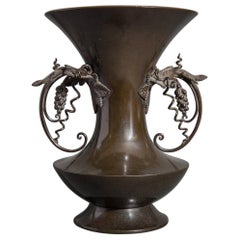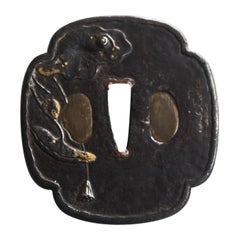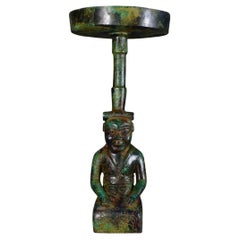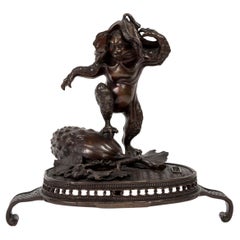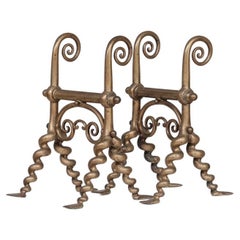Metalwork
to
116
444
388
945
86
42
11
3
1
1
1
128
945
840
28
434
177
55
39
12
18
7
12
7
21
9
5
2
933
310
221
182
166
704
530
349
163
84
945
945
945
14
4
4
3
3
Metalwork For Sale
Period: 19th Century
Period: Late 19th Century
19th Century Superior Quality Japanese Bronze Vase with Grape Vine Handles
Located in Hudson, NY
19th century superior quality Japanese bronze vase with grape vine handles. Beautifully shaped Edo period (first half of the 19th century) vase with c...
Category
Early 19th Century Japanese Edo Antique Metalwork
Materials
Bronze
19th Century Tsuba Old Guard Of Japanese Katana
Located in Marseille, FR
19th Century Tsuba former Japanese Katana guard in bronze and gilding, diameter approximately 8 cm.
Category
19th Century Japanese Antique Metalwork
Materials
Wrought Iron
Big Size Old Asian Bronze Kneeling Down Human Candle Stick Statue
Located in 景德镇市, CN
This Big Size Old Asian Bronze Kneeling Down Human Candle Stick Statue is a remarkable work of artistic craftsmanship and functional design. The statu...
Category
19th Century Antique Metalwork
Materials
Bronze
Japanese Bronze Kappa
Located in PARIS, FR
Dark brown patina bronze figure of a standing kappa with its right leg leaning on a cucumber. The figure is put on four-legged rattan-like bronze stand.
The kappa (??) is a aquatic creature taken from Japanese folklore having the appearance of an anthropomorphic turtle.
His skull is either slightly hollowed out to accommodate water, from which it derives its power, or hidden with a water lily leaf hiding this sag. Naturally polite, it is advisable to bow to him in order that it should do so in return, thus losing all the water he has gathered and leaving it harmless.
Kappa has the reputation of attempting to lure both humans and animals into the water. In some areas, it ravages fields, stealing eggplants and cucumbers. Some people prefer to worship it and give it offerings rather than be its victims.
Signed Shokaken (???). His real name is Ôshima Yasutarô. He was born in 1849 and is the third generation of a metalworkers family. Together with his brother Ôshima Joun...
Category
Late 19th Century Japanese Antique Metalwork
Materials
Bronze
Brass Aesthetic Antique Fire Dogs
Located in London, GB
A pair of good quality brass fire dogs in the aesthetic movement taste.
England, c1890s.
Small in size but very well crafted, remaining very contempo...
Category
19th Century British Antique Metalwork
Materials
Brass
Big Size Vintage Bronze Bull Statue Carving Ancient Characters
Located in 景德镇市, CN
This vintage bronze bull statue is a truly unique and special collectible piece.
Bull statue details:
Material: bronze
Height: 34cm
Length: 43cm
Wide: 20cm
Weight: 6150g
Originati...
Category
19th Century Antique Metalwork
Materials
Bronze
Old Chinese Iron Lantern
Located in 景德镇市, CN
This Old Chinese Iron Lantern is a beautiful and historical piece of Chinese craftsmanship, showcasing the timeless elegance and functionality of ...
Category
19th Century Antique Metalwork
Materials
Iron
Chinese Silver Repousse Dragon Handle Sauce Boat by Luen Wo
By Luen Wo
Located in Sarasota, FL
Chinese Export silver repousse sauce boat with dragon handles. Marked for Luen Wo.. Very fine decoration. 7 1/4" long, 4 " tall, 3 1/2", 7 oz weight.
Category
1890s Chinese Chinese Export Antique Metalwork
Materials
Silver
Japanese Meiji Period Mixed Metal Pair of Scroll Weights Depicting Samurai
Located in Sarasota, FL
Japanese Meiji period fine pair of scroll weights decorated with shakudo and silver samurai figures. The weights fill solid and heavy. One of the weights has Japanese writing ( see i...
Category
19th Century Japanese Meiji Antique Metalwork
Materials
Metal
Antique Indian Hindu Bronze Statue Krishna – 18th Century Asian Folk Art
Located in London, GB
Antique Indian Hindu Bronze Sculpture – Krishna with Flute (18th Century)
A captivating and finely crafted antique bronze figure depicting Lord Krishna, rendered in the distinctive ...
Category
19th Century Indian Antique Metalwork
Materials
Silver
Chinese Export Silver Dragon Repousse Tanakard
Located in Sarasota, FL
Chinese Export silver tankard with detailed repousse dragons and dragon handle.
The tankard is 5 3/4" tall, 3 1/4' in diameter, 4 1/8" at the handle....
Category
19th Century Chinese Chinese Export Antique Metalwork
Materials
Silver
Chinese Paktong Basin, 19th Century
Located in Lymington, Hampshire
A Chinese paktong basin, engraved with scenes of many children at play and before pagodas, within borders of shou characters, bats and flowerheads, the flattened rim with vases of flowers and lingzhi, swords, lotus pods...
Category
19th Century Japanese Meiji Antique Metalwork
Materials
Metal
Outstanding Meiji Period Mixed Metal Bell Casket by the Nogowa Foundary
Located in Lymington, Hampshire
Of typical form with a shibuichi ground worked in shakudo, silver and gold with a central continuous frieze showing a 3-toed dragon amongst roiling clouds and spume-flecked waves, the shoulders with fields of shakudo bosses between triple vertical lines, the knop formed by paired dragons...
Category
Late 19th Century Japanese Antique Metalwork
Materials
Metal
Chinese Vintage Bronze Kneeling Down Buddha Candle Holder Statue
Located in 景德镇市, CN
This Chinese Vintage Bronze Kneeling Down Buddha Candle Holder Statue is rare and special.
Unlike traditional Buddha sculptures that depict the figure seated in meditation, this par...
Category
19th Century Antique Metalwork
Materials
Bronze
76cm Vintage Bronze Two Sided Sitting Man on Lotus Stand
Located in 景德镇市, CN
Old collection of this Vintage Bronze Two Sided Sitting Man on Lotus Stand, unique style and exquisitely carved, it is a truly unique and special collectib...
Category
19th Century Antique Metalwork
Materials
Bronze
Middle Size Vintage Bronze Man Burner from China
Located in 景德镇市, CN
This Vintage Bronze Man Burner from China is a truly unique and special collectible piece.
Burner Details:
Material: bronze
30 cm high
16 cm wide and 10 cm deep
Originating from C...
Category
19th Century Antique Metalwork
Materials
Bronze
A Monumental Gilt-Lacquered Bronze Ornamental Buddha Sculpture of Vajravidarana
Located in New York, NY
A Monumental Gilt-Lacquered Bronze Ornamental Buddha Sculpture of Vajravidarana:
A Masterpiece of Sino-Tibetan Craftsmanship, Late 19th Century, Qing Dynasty
This monumental gilt-lacquered bronze ornamental sculpture of Vajravidarana is an extraordinary and commanding piece of art, showcasing the pinnacle of Sino-Tibetan craftsmanship from the late 19th century. The figure of Vajravidarana, a powerful purification deity in Tibetan Buddhism, is meticulously sculpted to embody both spiritual authority and artistic excellence.
Vajravidarana is primarily known for his role in removing spiritual impurities and negativities. Unlike other deities associated with wisdom or compassion, Vajravidarana’s function is centered on purification and healing. He is typically depicted holding a vajra and a bell, symbolizing the cutting away of delusions and the resonance of divine truth. In this striking sculpture, Vajravidarana is shown holding a vishva vajra (the double vajra), a unique and powerful variation of the traditional iconography, which signifies ultimate protection and the dispelling of negative karma.
Vajravidarana: The Supreme Purifier and Protector
Vajravidarana is revered in Tibetan Buddhism as the deity of spiritual purification, called upon to cleanse practitioners of defilements and negative influences. His vajra represents the indestructibility of truth, while his bell signifies the wisdom that resonates through purification rituals. In this sculpture, the presence of the vishva vajra, or double vajra, enhances his association with supreme protection, ensuring the destruction of all spiritual obstacles and afflictions.
The figure’s powerful yet composed expression conveys a sense of unwavering resolve and divine authority. His posture, along with the carefully sculpted details of his robes and ornaments, highlights his function as a guardian against impurity. The inclusion of the vishva vajra rather than the usual single vajra reinforces his role as a supreme protector, capable of dispelling all forms of negativity and restoring balance.
Symbolism of the Mantras and Aureole:
Unlike deities that embody wisdom through duality, Vajravidarana’s iconography is centered on purification and exorcism. The aureole surrounding him is inscribed with sacred purification mantras rather than depictions of a consort. These mantras emphasize his function as a remover of obstacles and impurities, reinforcing his role in Buddhist healing rituals.
The presence of the sacred inscriptions elevates the sculpture’s spiritual significance, making it a focal point for meditation and ritual purification. Practitioners often visualize Vajravidarana radiating purifying light, dissolving afflictions and negative karma. This theme is mirrored in the sculptural repetition of the purification symbols on the aureole, reinforcing the deity’s role as a divine cleanser.
Gilt-Lacquered Bronze: The Artistry of Sino-Tibetan Metalwork:
The craftsmanship of this monumental figure reflects the expertise of late 19th-century Sino-Tibetan metalwork, where traditional Tibetan themes were infused with Chinese artistic sensibilities. Cast in bronze and finished with a rich gilt lacquer, the statue has an otherworldly glow, giving it an ethereal, almost divine presence. The gilding process—applied with exceptional skill—gives the sculpture a striking luminosity that enhances the fine details of the facial features, flowing robes, jewelry, and other elements of the deity’s attire.
The technique employed to create this figure speaks to the high level of craftsmanship that flourished during the late Qing Dynasty and early modern Tibetan art. The ornate details of the robes and the fine texture of the sculpture highlight the exceptional skill of the artisans who brought this work to life. The use of gold and lacquer not only reflects the preciousness of the sculpture but also its spiritual significance as an object meant to inspire reverence and meditation.
An Ornamental Sculpture of Monumental Scale:
Unlike smaller devotional objects, this sculpture is designed as an ornamental masterpiece, intended to make a grand visual and spiritual statement. Its monumental size allows it to dominate any space, offering a commanding presence that is both physically and symbolically impressive. In Buddhist practice, large sculptures of this nature are often placed in temples or meditation halls, where their imposing size and serene presence would encourage contemplation and devotion.
The grand scale of the statue further amplifies the spiritual power it is meant to convey. As a representation of Vajravidarana, it is not only a physical object of beauty but also a conduit for meditation, purification, and enlightenment. The scale of the sculpture also emphasizes the divine stature of the deity, highlighting his importance in the Buddhist tradition as the ultimate force for spiritual cleansing and protection.
Provenance:
Acquired in China in circa 1900
1905 Private Buddhist Temple, Northeast, USA
Private Sale
Solomon Treasure...
Category
Late 19th Century Chinese Tibetan Antique Metalwork
Materials
Bronze
